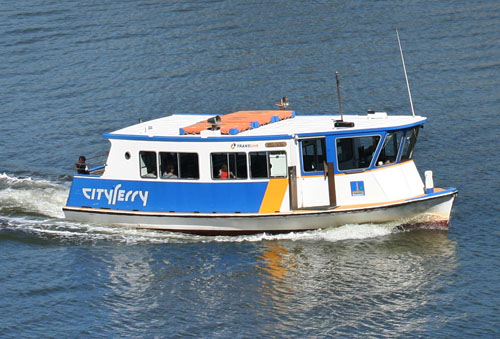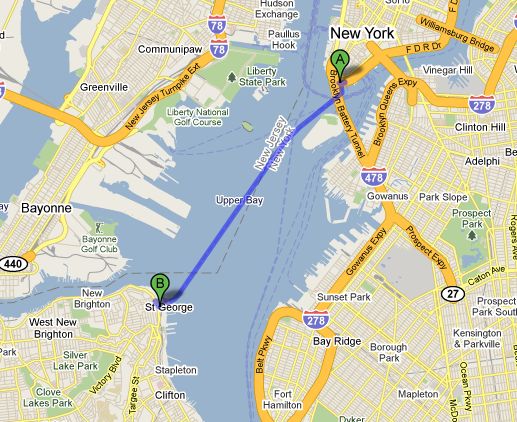
Brisbane’s cross-river ferry
Ferries are always an appealing transit idea. A serene way to travel when the weather is nice. Great views! And they must be reliable, because they never get stuck in congestion!
As always, there’s more to it. Ferries are sometimes the right answer, but the barriers they present often outweigh their benefits. Where should they seriously be considered?
Think of a ferry as a rapid transit line, minus the huge cost of land and rails and power supply, but unable to continue across a land-water boundary.
Like rail, ferries carry the limitation that everyone has to get off at the end of the line. Obviously you need transit connections there for onward journeys onto land, but the resulting passenger trips often require several changes of vehicle to continue in one direction, which is always less effective than services that can flow continuously across the city like a well-designed bus or rail line. So if the same market is already served by land transit using bridges or tunnels, ferries often struggle to compete, because bus and rail services can penetrate deeper into the city on both sides to complete logical networks.
Another constraint of ferries is that waterfront land is expensive, so it’s hard to find space at a ferry terminal for everything you’d want at a transit node, including terminals for connecting transit, transit-oriented development, and (if you must) commuter parking.
To overcome these limitations, a successful ferry line must have most or all the following necessary conditions.
- High frequency. Unless you have a huge rush-hour commute market, low frequency makes a service t0o narrowly specialized. Frequency requires minimizing on-board labor, as labor drives operating cost and thus constrains frequency. (Marine regulations in many countries are an obstacle to this.) Ferries with only one employee on board achieve frequency through low labor costs. See, for example, the privately owned micro-ferries on Vancouver’s False Creek (really a small, sheltered harbor) or the small cross-river ferries in Brisbane. These can do well with only moderate demand because they are so cheap to operate, and can build up useful frequency for the same reason.
- Very high density right in walking distance of the ferry terminal, preferably without major grades to climb. This is a challenge because if you draw a walk-access circle around a ferry terminal, most of it is usually water. Cities that slope upward steeply from the water, like Seattle, present further barriers. Using Park-and-Ride as the main method of ferry access almost never works, because waterfront land is too expensive for such an inefficient land use.
- Quality landside access by frequent connecting transit modes, sufficient to draw adequate all-day demand. This and the previous one can substitute for each other to a degree, but the most successful services have both. In Hong Kong, for example, there are large bus terminals at the major ferry terminals, despite astronomical land value and the many competing demands, because they really understand the importance of total networks, which in turn are built on easy connections.
- No competition from bridges or tunnels, especially those carrying frequent transit lines (rail or bus). Ferries just can’t compete, for high volume, with bridge-and-tunnel services. Sometimes ferries are run to densely populated coves where the competing bridge or tunnel lands too far back from the water to serve the area, as on New York’s East River, but in this case you have to fill the ferry solely with waterfront demand, because people inland will take the bridge or tunnel service.
- A Direct Path. Ferries along twisting rivers are often disappointing, unless the available land-based paths are equally indirect.
- Few Major Terminals, Not Many Little Ones. A common mistake in ferry planning is to build too many little terminals, each with too small a market, so that they don’t support enough frequency to be useful. Auckland and Sydney, for example, have lots of ferry terminals in bucolic suburban coves, down a steep hill from most nearby residents, where there are just not enough people. These tend to become elite services and often not very productive ones. Fewer stops with larger demand is the key, just in the most productive land-based networks.
- Favorable Pricing. If there is any possible competition with bridge/tunnel service, the ferry needs to be cheaper to use, counting the total trip including any connections. It’s often hard to justify that if there is more than one employee per vehicle.

The immensely successful Staten Island Ferry has all the necessary features, including huge transit networks converging on both ends.
Really successful ferries, like New York’s Staten Island Ferry or Hong Kong’s Star Ferry, have all of these features. At a smaller scale, Brisbane’s cross river ferries and Vancouver’s False Creek ferries, both with just one employee per vehicle, scale well for short trips across a water barrier.
The romantic and scenic qualities of ferries always generate support, just as happens with rail services, but service must be useful, compared to your alternatives, if it is to succeed long-term. Tourism and recreation are often cited as markets, but unless you have a supercharged tourism sector, and the right kind of service and connections, this market is easily overstated due to inevitable private sector boosterism.
As always, if the ridership prospects are low and the benefits are mostly private, the funding should be private as well. Encourage the tourist sector to fund tourist ferries directly, just as you would for any service precision-designed around a single interest. The same could be said for small, low-demand ferries that mostly benefit a single development or specialized community.
So yes, ferries are good at certain things, but destinations along the water, and some local enthusiasm, isn’t enough to ensure a successful ferry project.